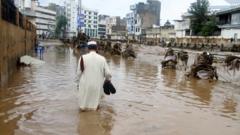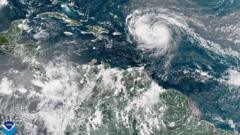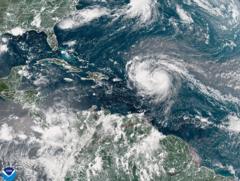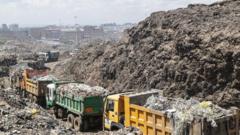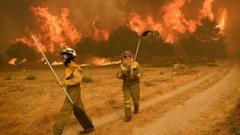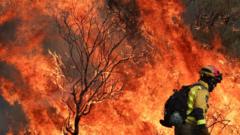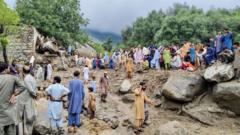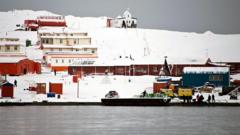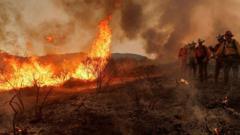Recent analysis reveals that glaciers worldwide are melting faster than ever recorded, threatening millions who depend on this critical freshwater resource. In the last two decades, an extensive study has captured the scale of this crisis, highlighting the accelerated loss of ice and its implications for sea-level rise.
World's Glaciers in Rapid Decline: Unprecedented Melt Rates Observed

World's Glaciers in Rapid Decline: Unprecedented Melt Rates Observed
As the planet heats up, glaciers are disappearing at an alarming rate, presenting a dire outlook for global freshwater supplies.
The Aletsch Glacier, spanning over 20 km in the European Alps, has retreated by 3.2 km since 1900, with more than 1 km of that loss occurring since 2000. Climate change has become the driving force behind this unsettling trend, as mountain glaciers—often referred to as frozen rivers of ice—supply freshwater to countless communities. According to the latest findings, glaciers have shed over 6,500 billion tonnes, equating to a 5% loss of their total mass since the beginning of the century.
Efforts to quantify the melting glaciers involved a comprehensive analysis from 35 research teams, compiling over 230 regional estimates. This marks a significant advancement in understanding the precise rate at which glaciers are shrinking and how they might continue to evolve in the face of climate change.
Under normal conditions, glaciers maintain their size through a balance of snowfall and melting. However, an alarming upward trend in temperatures due to human activities, particularly fossil fuel combustion, has led to a consistent reduction in glacier size for over 20 years. Data shows that, outside of the vast ice sheets of Antarctica and Greenland, these glaciers lost an average of 270 billion tonnes of ice annually between 2000 and 2023.
To grasp the magnitude of the annual ice loss, Michael Zemp, the director of the World Glacier Monitoring Service, likened it to the cumulative water consumption of the global population over 30 years, assuming 3 litres per person per day.
Certain regions are witnessing even more dramatic glacier loss, with Central Europe experiencing a staggering 39% reduction in glacier ice within just over two decades. The novelties of this research, published in the journal Nature, lie in its extensive collaboration among scientists, enhancing the credibility of the findings.
Effectively estimating glacier changes involves combining various methods, which include satellite data and field measurements. While direct measurements yield precise data, they apply only to a small fraction of glaciers worldwide. By employing diverse approaches, researchers have gained greater insight into the ongoing melting phenomenon.
Gaining confidence in these community estimates is crucial for climate scientists, policymakers, and industries focused on mitigating the impacts of climate change. As glaciers may take years or decades to fully respond to the changing climate, persistent melting is anticipated for the foreseeable future. Importantly, the extent of ice loss by the century's end hinges on how effectively humanity can curb carbon dioxide emissions and greenhouse gas releases.
Meeting global climate targets could see a loss of one-quarter of the world’s glacier ice, whereas uncontrolled warming could lead to losses nearing half, with every fraction of a degree of warming avoided preserving precious glacier mass and mitigating associated damages, according to Prof. Zemp.
The ramifications of glacier melt reach far beyond localized impacts. Globally, hundreds of millions depend on seasonal glacier meltwater, crucial for drought resistance. As these glaciers vanish, so too does their water supply.
Moreover, even slight increases in global sea levels can result in extensive coastal flooding. Prof. Shepherd stresses that each centimeter of sea-level rise exposes an additional 2 million individuals to annual flooding risks. Since 1900, global sea levels have surged by over 20 cm, with accelerated increases anticipated in the coming decades.
The future of glaciers and their essential role in our planet's ecosystem hangs in the balance as humanity navigates the challenges of climate change and its far-reaching impacts.
Efforts to quantify the melting glaciers involved a comprehensive analysis from 35 research teams, compiling over 230 regional estimates. This marks a significant advancement in understanding the precise rate at which glaciers are shrinking and how they might continue to evolve in the face of climate change.
Under normal conditions, glaciers maintain their size through a balance of snowfall and melting. However, an alarming upward trend in temperatures due to human activities, particularly fossil fuel combustion, has led to a consistent reduction in glacier size for over 20 years. Data shows that, outside of the vast ice sheets of Antarctica and Greenland, these glaciers lost an average of 270 billion tonnes of ice annually between 2000 and 2023.
To grasp the magnitude of the annual ice loss, Michael Zemp, the director of the World Glacier Monitoring Service, likened it to the cumulative water consumption of the global population over 30 years, assuming 3 litres per person per day.
Certain regions are witnessing even more dramatic glacier loss, with Central Europe experiencing a staggering 39% reduction in glacier ice within just over two decades. The novelties of this research, published in the journal Nature, lie in its extensive collaboration among scientists, enhancing the credibility of the findings.
Effectively estimating glacier changes involves combining various methods, which include satellite data and field measurements. While direct measurements yield precise data, they apply only to a small fraction of glaciers worldwide. By employing diverse approaches, researchers have gained greater insight into the ongoing melting phenomenon.
Gaining confidence in these community estimates is crucial for climate scientists, policymakers, and industries focused on mitigating the impacts of climate change. As glaciers may take years or decades to fully respond to the changing climate, persistent melting is anticipated for the foreseeable future. Importantly, the extent of ice loss by the century's end hinges on how effectively humanity can curb carbon dioxide emissions and greenhouse gas releases.
Meeting global climate targets could see a loss of one-quarter of the world’s glacier ice, whereas uncontrolled warming could lead to losses nearing half, with every fraction of a degree of warming avoided preserving precious glacier mass and mitigating associated damages, according to Prof. Zemp.
The ramifications of glacier melt reach far beyond localized impacts. Globally, hundreds of millions depend on seasonal glacier meltwater, crucial for drought resistance. As these glaciers vanish, so too does their water supply.
Moreover, even slight increases in global sea levels can result in extensive coastal flooding. Prof. Shepherd stresses that each centimeter of sea-level rise exposes an additional 2 million individuals to annual flooding risks. Since 1900, global sea levels have surged by over 20 cm, with accelerated increases anticipated in the coming decades.
The future of glaciers and their essential role in our planet's ecosystem hangs in the balance as humanity navigates the challenges of climate change and its far-reaching impacts.


